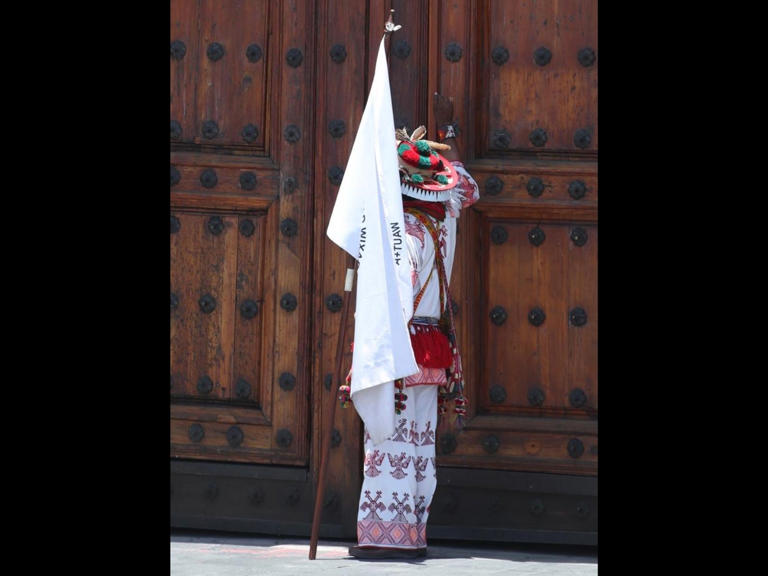by Luis Hernández Navarro
Over 32 days, more than 200 members of the Wuaut+a-Kuruxi Manuwe (San Sebastían Teponahuaxtlán and its annex Tuxpan de Bolaños), located in the municipality of Mezquitic, Jalisco, walked 900 kilometers to arrive in Mexico City, visit the Basilica of Guadalupe and knock on the doors of the National Palace. They belong to the wixárika people, the people with deep hearts who know. Their goal: to meet respectfully with President Andrés Manuel López Obrador.

Tireless pilgrims, they organized the Wixárika Caravan for Dignity and Conscience to have their lands and territories restored to them— lands which have been illegally invaded by mestizo ranchers protected by agrarian authorities. In their pilgrimage, they carry offerings, perform rituals and learn from the voice of their gods what the custom says.
Despite being a compact demographic, ethnic and cultural unit, the Wixaritari territory spreads out like a hand, across Jalisco, Nayarit, Durango, Zacatecas, and San Luis Potosí. The lines between them separate them into artificial borders. Despite having protected lands with titles in their name since 1718, in the midst of the colonial era, they have confronted aggressive mestizo settlers who illegally acquired the land at the beginning of the last century. The new conquistadors began by renting pasture from the community and later took over the land.
The situation has become more entangled over the years, by the overlapping of plans between provisional endowments, presidential resolutions, omission and the negligence of the [office of] Agrarian Reform. In lieu of finding a solution to the conflict, government authorities at all levels have dragged their feet. Many of them have shown their cards by legalizing dispossession in favor of the small landowners.
On January 6th of 1992, agrarian distribution in the country was terminated. With the stroke of a pen, the precepts that regulated the prohibition of the latifundia and the distribution of lands, as well as the institutions in charge of the same, were abolished. In spite of this unfavorable legal framework, the wixárika communities, blessed with centuries of patience, have managed to recover some of their territories, making use of every legal loophole available.
Tirelessly, over the past decades, they have knocked, again and again, with unity, determination and flexibility, on the door of government institutions to demand justice. They have attended countless and often fruitless official meetings in Tepic, Guadalajara and Mexico City. And, in order to be seen beyond their beautiful handicrafts, in the absence of a solution to their demands, they have taken to the streets and recovered, through deeds, lands that belong to them.
The Huichol mobilization for the ownership of their territory has come a long way. Despite countless adversities, they have reconstituted themselves as a people in recent years. In March of 1997 they marched for the first time in the city of Guadalajara, demanding the implementation of the Accords of San Andrés1. Since then, they have not stopped. The protests have grown in waves, combining agrarian proceedings, occupation of lands, pilgrimages, rites and long caravans.
Wixaritari resistance encompasses many aspects, in addition to the agrarian-territorial. The multiplication of mining concessions to devastating companies, like that of the Wirikuta, is one of the most barbaric links in a chain of aggressions.
As a people, it preserves its religiosity around the worship of deer, peyote and corn. These practices clash not only with other religious expressions, but also with legislation. The harassment of uniformed officers against their devotional expressions and the destruction of sacred sites is common. The police have assaulted the jicareros (pilgrims commissioned by their community) during their ceremonies. Large agroindustrial companies which suppress the rain with detonations in the sky to disperse the clouds, destroy campesino life in the Wirikuta desert. The sacred zones of Hara Mara (San Blas, Nayarit) were concessioned to tourist companies. The main prayer centers have been commercialized. Important sacred sites were inundated by La Yesca and El Cajón dams in Nayarit. The Bolaños-Huejuquilla highway project in Jalisco, destroyed and buried the sacred Paso del Oso site.
The wirras keep their forms of social organization, language, traditional authorities and normative systems alive in permanent confrontation with the governmental imposition of authorities. For that, they have faced all kinds of insults. To stigmatize their last pilgrimage to Mexico City, there was malicious slander spread that the march was sponsored by Movimiento Ciudadano2.

The Caravaners of Dignity and Conscience began walking on April 22nd, with the purpose of requesting of Federal Executive that the territory, which was recognized by presidential resolution on July 15th, 1953, and a protection 240-447 ha-4a-Oca, published in the Diario Oficial de la Federación (Official Journal of the Federation) on September 19th of the same year, be restored to them; as a precedent, in 1718, the Spanish crown, by viceregal title, recognized the wixárika people as the “legitimate owner of their lands.”
The effort was not in vain. This Monday, May 30th, President López Obrador received them at the National Palace and committed to the restitution of 11 thousand hectares. Today, justice for the heroic Wixárika people is a little bit closer.
This piece was published in La Jornada on May 31, 2022. https://www.jornada.com.mx/2022/05/31/opinion/014a2pol English translation by Schools for Chiapas.
Footnotes
- The San Andrés Accords, agreements reached between the Mexican government and the EZLN were based on five principles of respect for the diversity of indigenous peoples, which included the right to autonomy of the communities. These agreements languished for over 4 years before they were betrayed by the State
- A center-left Mexican political party
